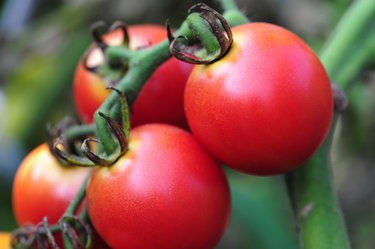
Oxalate is a chemical compound that occurs naturally in almost every plant to some degree, including fruit, vegetable and grain plants. Oxalate is usually located in leaves or bark, where the compound binds with calcium to remove it when plants go through their seasonal shedding. In the human body, oxalate has no beneficial function and is almost entirely excreted as waste in urine and stool, according to "The Kidney Stones Handbook."
Oxalates in Digestion
Video of the Day
The average daily diet contains about 120 mg of oxalate, but can contain upwards of 1,000 mg in those who consume a large quantity of high-oxalate foods. When you eat foods that contain oxalate, acids in your stomach free the compound from its source. Your liver also converts excess amounts of vitamin C and animal protein to oxalate. Further along in the digestive process, oxalate bonds strongly with calcium, forming a compound that is eventually excreted in the stool. This binding process prevents the absorption of oxalates, as well as the calcium with which they bind. A relatively healthy body normally absorbs 10 to 15 percent of unbound dietary oxalate, which is then excreted through urine.
Video of the Day
Kidney Stones
Your kidneys act as a filter for your body, dissolving and excreting all the waste products in a complex process requiring the proper balance of urinary chemicals and water. When not enough water is available to dissolve all of the filtered material, hardened mineral deposits called kidney stones can form. Stones are abnormal growths. They begin as microscopic particles, grow into a collection of crystals and eventually form stones. Depending on how they were made, stones can contain a variety of different compounds. Almost 85 percent of kidney stones contain calcium. While some of these stones contain the compound calcium phosphate, a majority contain calcium oxalate. If you're prone to the development of oxalate-containing kidney stones, your physician might recommend that you limit your intake of oxalate-containing foods.
Tomatoes
Tomatoes belong to the nightshade plant family, along with eggplant, potatoes and bell peppers. While these other nightshade plants contain a "high" amount of oxalate, or more than 10 mg per serving, tomatoes contain only a "moderate" amount, or between 2 and 10 mg per serving. The U.S. Department of Agriculture lists the oxalic acid content of tomatoes at 50 mg per 100 g serving. The oxalate content of any one type of food is highly variable, however, depending on the state of ripeness and climate, as well as soil conditions. Very ripe tomatoes, for example, generally contain higher oxalate amounts than less mature fruit. According to "The Encyclopedia of Healing Foods," published reports of oxalate levels in one specific food can differ 2- to 15-fold.
Considerations
Unless you have a family history of kidney stones, or your health care provider has advised you to limit your intake of oxalates due to a diagnosed health condition, you don't need to worry about the oxalic acid in the food you eat. Besides being a source of a moderate amount of oxalate, tomatoes are an excellent source of vitamins C and K, biotin and carotenes, including lycopene, an antioxidant that protects against skin, lung, breast, colon and prostate cancers, and might lower the risk of heart disease and cataracts. Tomatoes are also a very good source of dietary fiber, folic acid and vitamin B6. Although the oxalate content in tomatoes increases as they ripen, so does their nutrient content.